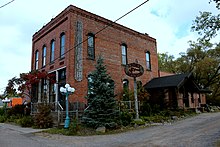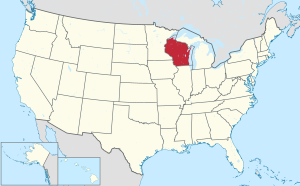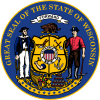Sawyer County, Wisconsin
Sawyer County | |
|---|---|
U.S. county | |
 | |
 Location within the U.S. state of Wisconsin | |
 Wisconsin's location within the U.S. | |
| Coordinates: 45°54′N 91°08′W / 45.9°N 91.14°W | |
| Country | |
| State | |
| Founded | 1885 |
| Named for | Philetus Sawyer |
| Seat | Hayward |
| Largest city | Hayward |
| Area | |
| • Total | 1,350 sq mi (3,500 km2) |
| • Land | 1,257 sq mi (3,260 km2) |
| • Water | 93 sq mi (240 km2) 6.9%% |
| Population (2010) | |
| • Total | 16,557 |
| • Estimate (2020) | 16,700 |
| • Density | 12/sq mi (4.7/km2) |
| Time zone | UTC−6 (Central) |
| • Summer (DST) | UTC−5 (CDT) |
| Congressional district | 7th |
| Website | www |
Sawyer County is a county in the U.S. state of Wisconsin. As of the 2010 census, the population was 16,557.[1] Its county seat is Hayward.[2]
History[]
The county is named for Philetus Sawyer, a New England man who represented Wisconsin in the U.S. House of Representatives and U.S. Senate in the 19th century.[3] Logging began in the late 1850s. Loggers came from Cortland County, New York, Carroll County, New Hampshire, Orange County, Vermont and Down East Maine in what is now Washington County, Maine and Hancock County, Maine. These were "Yankee" migrants, that is to say they were descended from the English Puritans who had settled New England during the 1600s. They were mostly members of the Congregational Church.[4] Sawyer County was created in 1883 and organized in 1885.[5] In the 1890s immigrants came from a variety of countries such as Germany, Norway, Poland, Ireland and Sweden.
Geography[]
According to the U.S. Census Bureau, the county has a total area of 1,350 square miles (3,500 km2), of which 1,257 square miles (3,260 km2) is land and 93 square miles (240 km2) (6.9%) is water.[6] It is the fifth-largest county in Wisconsin by land area.
Major highways[]

 U.S. Highway 63
U.S. Highway 63 Highway 27 (Wisconsin)
Highway 27 (Wisconsin) Highway 40 (Wisconsin)
Highway 40 (Wisconsin) Highway 48 (Wisconsin)
Highway 48 (Wisconsin) Highway 70 (Wisconsin)
Highway 70 (Wisconsin) Highway 77 (Wisconsin)
Highway 77 (Wisconsin)- Sawyer County Highway B is the busiest rural roadway on average in all of Sawyer County with a high count of 5900 vehicles daily, according to the Wisconsin Department of Transportation's average daily traffic maps for 2008. https://web.archive.org/web/20100602030241/http://www.dot.wisconsin.gov/travel/counts/docs/sawyer/sawyer2008.pdf
Airport[]
Sawyer County Airport (KHYR) serves the county and surrounding communities.
Adjacent counties[]
- Bayfield County - north
- Ashland County - northeast
- Price County - east
- Rusk County - south
- Barron County - southwest
- Washburn County - west
- Douglas County - northwest
National protected areas[]
- Chequamegon National Forest (part)
- Saint Croix National Scenic Riverway (part)
Demographics[]
| Historical population | |||
|---|---|---|---|
| Census | Pop. | %± | |
| 1890 | 1,977 | — | |
| 1900 | 3,593 | 81.7% | |
| 1910 | 6,227 | 73.3% | |
| 1920 | 8,243 | 32.4% | |
| 1930 | 8,878 | 7.7% | |
| 1940 | 11,540 | 30.0% | |
| 1950 | 10,323 | −10.5% | |
| 1960 | 9,475 | −8.2% | |
| 1970 | 9,670 | 2.1% | |
| 1980 | 12,843 | 32.8% | |
| 1990 | 14,181 | 10.4% | |
| 2000 | 16,196 | 14.2% | |
| 2010 | 16,557 | 2.2% | |
| 2020 (est.) | 16,700 | [7] | 0.9% |
| U.S. Decennial Census[8] 1790–1960[9] 1900–1990[10] 1990–2000[11] 2010–2020[1] | |||

As of the census[12] of 2000, there were 16,196 people, 6,640 households, and 4,581 families residing in the county. The population density was 13 people per square mile (5/km2). There were 13,722 housing units at an average density of 11 per square mile (4/km2). The racial makeup of the county was 81.72% White, 0.31% Black or African American, 16.07% Native American, 0.30% Asian, 0.02% Pacific Islander, 0.35% from other races, and 1.23% from two or more races. 0.90% of the population were Hispanic or Latino of any race. 29.6% were of German, 7.8% Irish, 6.7% Norwegian, 5.9% Polish, 5.2% Swedish and 5.2% English ancestry. 95.4% spoke English, 2.0% Ojibwa and 1.1% Spanish as their first language.
There were 6,640 households, out of which 27.50% had children under the age of 18 living with them, 54.20% were married couples living together, 10.00% had a female householder with no husband present, and 31.00% were non-families. 26.20% of all households were made up of individuals, and 11.70% had someone living alone who was 65 years of age or older. The average household size was 2.39 and the average family size was 2.86.
In the county, the population was spread out, with 24.10% under the age of 18, 6.00% from 18 to 24, 24.60% from 25 to 44, 27.40% from 45 to 64, and 17.90% who were 65 years of age or older. The median age was 42 years. For every 100 females there were 101.80 males. For every 100 females age 18 and over, there were 101.00 males.
In 2017, there were 167 births, giving a general fertility rate of 74.5 births per 1000 women aged 15–44, the 8th highest rate out of all 72 Wisconsin counties.[13] Additionally, there were fewer than five reported induced abortions performed on women of Sawyer County residence in 2017.[14]
Communities[]
Cities[]
- Hayward (county seat)
Villages[]
Towns[]
Census-designated places[]
- Chief Lake
- Little Round Lake
- New Post
- Reserve
- Stone Lake (partial)
Unincorporated communities[]
Politics[]
Sawyer County is a bellwether county in presidential elections, having voted for the overall national winner in every election from 1964. This streak was broken in 2020 when the county backed Donald Trump, who lost to Joe Biden. This is similar to numerous other bellwether counties [1]. This is because of the greater geographic polarization in American politics, with fewer and fewer counties swinging between parties but instead consistently voting for one party according to demographics. [15]
See also[]
References[]
- ^ Jump up to: a b "State & County QuickFacts". United States Census Bureau. Archived from the original on July 18, 2011. Retrieved January 23, 2014.
- ^ "Find a County". National Association of Counties. Retrieved June 7, 2011.
- ^ "Winnebago Took Its Name from an Indian Tribe". The Post-Crescent. December 28, 1963. p. 14. Retrieved August 25, 2014 – via Newspapers.com.

- ^ History of Education in Sawyer County, Wisconsin by J. G. Adams (M.E. Granger, 1902)
- ^ "Wisconsin: Individual County Chronologies". Wisconsin Atlas of Historical County Boundaries. The Newberry Library. 2007. Archived from the original on April 14, 2017. Retrieved August 15, 2015.
- ^ "2010 Census Gazetteer Files". United States Census Bureau. August 22, 2012. Retrieved August 9, 2015.
- ^ "County Population Totals: 2010-2020". Retrieved June 20, 2021.
- ^ "U.S. Decennial Census". United States Census Bureau. Retrieved August 9, 2015.
- ^ "Historical Census Browser". University of Virginia Library. Retrieved August 9, 2015.
- ^ Forstall, Richard L., ed. (March 27, 1995). "Population of Counties by Decennial Census: 1900 to 1990". United States Census Bureau. Retrieved August 9, 2015.
- ^ "Census 2000 PHC-T-4. Ranking Tables for Counties: 1990 and 2000" (PDF). United States Census Bureau. April 2, 2001. Retrieved August 9, 2015.
- ^ "U.S. Census website". United States Census Bureau. Retrieved May 14, 2011.
- ^ "Annual Wisconsin Birth and Infant Mortality Report, 2017 P-01161-19 (June 2019): Detailed Tables". Archived from the original on June 19, 2019. Retrieved June 20, 2019.
- ^ Reported Induced Abortions in Wisconsin, Office of Health Informatics, Division of Public Health, Wisconsin Department of Health Services. Section: Trend Information, 2013-2017, Table 18, pages 17-18
- ^ "Political Polarization's Geographic Roots Run Deep". Retrieved April 11, 2021.
- ^ Leip, David. "Dave Leip's Atlas of U.S. Presidential Elections". uselectionatlas.org. Retrieved February 8, 2021.
Further reading[]
- Clark, W. N. and M. H. Clark. A Short History of Southern Sawyer County. Eau Claire, Wis.: Wisconsin Colonization Co., 1920.
External links[]
| Wikimedia Commons has media related to Sawyer County, Wisconsin. |
- Sawyer County government website
- Sawyer County map from the Wisconsin Department of Transportation
- Wisconsin counties
- Sawyer County, Wisconsin
- 1885 establishments in Wisconsin
- Populated places established in 1885


